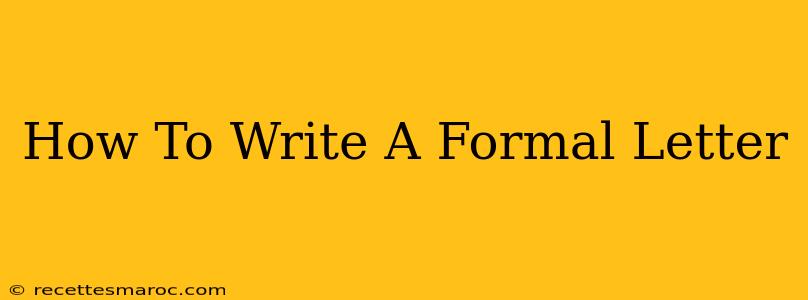Writing a formal letter can feel daunting, but with the right approach, it becomes a straightforward process. This guide provides a step-by-step approach to crafting professional and effective formal letters, covering everything from formatting to tone. Mastering this skill is crucial for various situations, from applying for jobs and making formal complaints to requesting information or writing to official bodies.
Understanding the Purpose of a Formal Letter
Before you begin writing, it's crucial to understand the purpose of your letter. What do you want to achieve? Are you requesting information, making a complaint, applying for a position, or something else entirely? Clearly defining your objective will guide the content and tone of your letter.
Key Elements of a Formal Letter
A formal letter adheres to a specific structure and format. Mastering these elements ensures your communication is clear, professional, and easily understood.
1. Your Contact Information
- Your Full Name: Place this at the top left-hand corner.
- Your Address: Include your street address, city, state, and zip code.
- Your Phone Number: Provide a reliable phone number where you can be reached.
- Your Email Address: Include a professional email address.
2. Date
- Write the date directly below your contact information. Use a standard date format (e.g., October 26, 2023).
3. Recipient's Contact Information
- Recipient's Full Name: If you know it, include the recipient's full name.
- Recipient's Title: Include their job title (e.g., Human Resources Manager, Director of Sales).
- Company Name (if applicable): Include the company name if writing to a business.
- Company Address: Include the full address of the recipient.
4. Salutation
- Use a formal salutation, such as "Dear Mr./Ms./Mx. [Last Name]," If you are unsure of the recipient's gender, using "Dear [Last Name]," is acceptable. Avoid informal salutations like "Hi" or "Hey."
5. Body Paragraphs
- Keep it concise and to the point: Avoid unnecessary wordiness.
- One paragraph per topic: Organize your letter logically, addressing each point in a separate paragraph.
- Use formal language: Avoid slang, colloquialisms, and contractions.
- Maintain a professional tone: Be polite, respectful, and objective.
6. Closing
- Use a formal closing, such as "Sincerely," "Respectfully," or "Regards."
- Signature: Leave space for your handwritten signature.
- Typed Name: Type your full name below your signature.
Tips for Writing an Effective Formal Letter
- Proofread carefully: Errors in grammar and spelling can damage your credibility.
- Use a professional font: Times New Roman or Arial are good choices.
- Use a clear and legible font size: Size 12 is generally recommended.
- Maintain consistent formatting: Ensure your letter looks clean and organized.
- Keep it concise: Get straight to the point and avoid unnecessary details.
- State your purpose clearly: Make it clear what you want the recipient to do.
Examples of Formal Letters
Numerous situations call for formal letters. Here are a few examples:
Job Application Letter: This letter should highlight your skills and experience, demonstrating why you are a suitable candidate for the position.
Complaint Letter: This letter should clearly and calmly outline the issue, providing specific details and requesting a resolution.
Request Letter: This letter should politely and professionally state your request, explaining your reasons and providing any necessary information.
Mastering the Art of Formal Letter Writing
By following these guidelines, you can confidently write effective and professional formal letters for any situation. Remember, clarity, conciseness, and professionalism are key to making a positive impression. Practice makes perfect, so don't hesitate to write several drafts before finalizing your letter. This attention to detail will significantly improve your chances of achieving your desired outcome.

